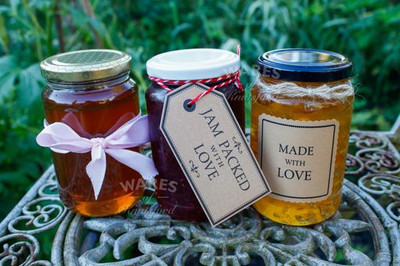As spring arrives in the garden, our thoughts turn to jam making
Posted by The Wares Team on 30th Mar 2021
Our thoughts are never far from jam making, truth be told. Homemade jam celebrates springtime in the best possible way. The ritual of preserving captures seasonal flavours. Refreshing tart sweetness complements the riot of burgeoning colour in our gardens.
Growing ingredients to make your own jam is much easier than you think. Passionate purveyors of preserving paraphernalia that we are, we’ve selected a seasonal darling of a recipe. Not only that, we’re sharing how easy it is to grow the ingredients yourself.
Gooseberry and sloe gin jam combines distinctly English flavours delivering refreshing springtime tartness - in late summer. Springtime is our opportunity plant gooseberry and sloes for your supply of gorgeous syrupy jam.
Glass jars, sloes and gooseberries
Sloes are found on the hardy blackthorn shrub. Blackthorn is a great addition to the garden because it flourishes easily (40-60cm a year). Its pearly white early springtime blooms entice birds and other pollinating creatures to nest and visit. Birds favour the blackthorn because of its network of thorns, which can grow up to 10cm long! Serrated leaves give plump caterpillars, colourful butterflies and moths their grub. The shrub itself is a fantastic windbreaker. The chaotic arrangement of gnarly branches are regarded as excellent wood, and create interesting walking sticks.
Similar to sloes, gooseberries love a sunny spot of the garden and grow easily. A lovely advantage of a gooseberry plant is it can be grown in the soil or trained to trail along a wall if your garden is on the cosy side. Early spring is 'last orders' to plant your bare-root gooseberry bush. Choose young bushes up to three years old showing a healthy head of up to five branches and a naked stem measuring up to 15cm.
Gooseberry bushes love space and air circulation. If you are planting more than one gooseberry bush please leave room between them to avoid gooseberry mildew. A reliable distance is 1.5m. Mulch to help settle in but avoid the stem area as this can encourage rot. Once you’ve mulched you shouldn’t need to water your gooseberry bush unless conditions are especially arid, in which case water once every two weeks.
To plant your blackthorn in spring, your best option is to purchase a young blackthorn. Cheap as chips and easily sourced from local nurseries, both as bare root and pot grown. Springtime planting requires pot grown blackthorn.
Position your blackthorn away from full shade, ideally in a sunny secluded area, to save yourself from being scratched by the thorns. The richer the soil, the better. Blackthorn will flourish in most soils, though. Mulch and water regularly to settle in. Blackthorns flourish in damp, well-drained soil.
Harvesting sloes and gooseberries for glass jars of juicy jam
Your gooseberries can be harvested from the beginning of July. The birds will let you know when the fruit has arrived. Share the bounty then protect your berries with horticultural netting. We need tarter gooseberries for jam so you’ll pick one month earlier. If you want sweet and fully ripe gooseberries later in the summer, make sure you pick every other fruit when you undertake this harvest in June.
Despite the scary sounding thorns, picking sloes is easy. Velvety dark purple fruit is ready from October through December. The challenge is when to harvest. Too early and the sloes will be way too bitter. When the garden has experienced two or more frost spells the fruit will be at its best for harvesting. Ask relatives for sloe gin recipes or source online to fill up glass bottles with your homemade version.
Line up your glass jars for gorgeous gooseberry and sloe gin jam
This delectable intrinsically English jam recipe is super straightforward:
Gather 1 kilo of tart gooseberries. Wash, then top and tail them, and set beside the rest of your ingredients:
1 kilo sugar
lemon juice (half a lemon)
5 tablespoons of homemade sloe gin
Topple your sloes into a thick bottomed saucepan. Add approximately half a cup of cold water. Heat slowly, stirring every now and again until boiling. Add water if mixture becomes dry. Your goal is to break up the gooseberries and, depending on their tartness, this step should take around 15 minutes.
Add lemon juice and sugar, and maintain the low heat. Stir until the sugar dissolves, and then whack up the heat until the jam is ready to set. The colour of the concoction will be a gorgeous purpley pink. Check whether your jam is set either with a thermometer or the old school set test.
Once set, remove from the heat. Purge any gunge or other foamy bits from the top. Add your sloe gin, stirring it in, before leaving the mixture to cool. Return a little while later, stir once again and fill your glass bottles and jars. A wickedly delicious homegrown and homemade tea time treat. Gift to loved ones and neighbours to celebrate springtime in the garden.

